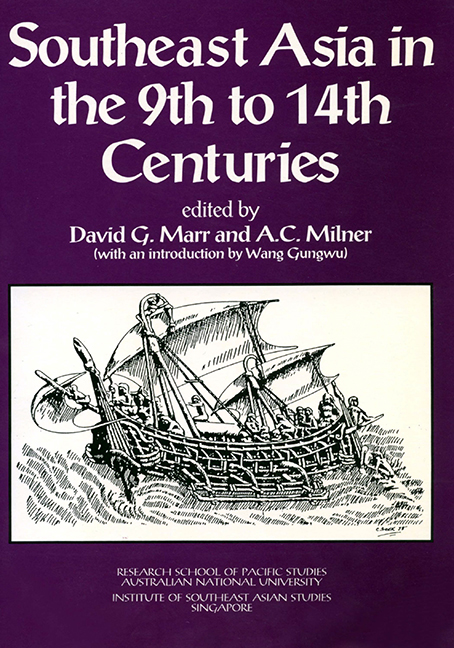Book contents
- Frontmatter
- Contents
- Contributors
- Preface
- Introduction
- 1 The Early and the Imperial Kingdom in Southeast Asian History
- 2 Hydraulic Works and South East Asian Polities
- 3 Some Notes on Relations between Central and Local Government in Ancient Java
- 4 Negara, Mandala, and Despotic State: Images of Early Java
- 5 Some Remarks on Early State Formation in Cambodia
- 6 “Elephants Can Actually Swim”: Contemporary Chinese Views of Late Ly Dai Viet
- 7 Authority and Legitimacy in 11th Century Vietnam
- 8 From Myth to History: Imagined Polities in 14th Century Vietnam
- 9 Shipshape Societies: Boat Symbolism and Political Systems in Insular Southeast Asia
- 10 Changing Perspectives in Island Southeast Asia
- 11 Political and Cultural Continuities at Dvaravati Sites
- 12 The True and the Corbel Arch in Mainland Southeast Asian Monumental Architecture
- 13 Vietnamese Ceramics and Cultural Identity: Evidence from the Ly and Tran Dynasties
- 14 Traditions, Acculturation, Renovation: The Evolutional Pattern of Vietnamese Culture
- 15 Symbolism of Kingship in Arakan
- 16 Buddhism in Champa
- 17 The Ordering of Generations: Change and Continuity in Old Javanese Kinship
- 18 Sources on Economic Activities in Khmer and Cham Lands
- 19 Narrative Bas-Reliefs at Candi Surawana
- 20 Possibilities for a Reading of the 1293-1357 Period in the Vietnamese Annals
- Index
- Miscellaneous Endmatter
5 - Some Remarks on Early State Formation in Cambodia
Published online by Cambridge University Press: 21 October 2015
- Frontmatter
- Contents
- Contributors
- Preface
- Introduction
- 1 The Early and the Imperial Kingdom in Southeast Asian History
- 2 Hydraulic Works and South East Asian Polities
- 3 Some Notes on Relations between Central and Local Government in Ancient Java
- 4 Negara, Mandala, and Despotic State: Images of Early Java
- 5 Some Remarks on Early State Formation in Cambodia
- 6 “Elephants Can Actually Swim”: Contemporary Chinese Views of Late Ly Dai Viet
- 7 Authority and Legitimacy in 11th Century Vietnam
- 8 From Myth to History: Imagined Polities in 14th Century Vietnam
- 9 Shipshape Societies: Boat Symbolism and Political Systems in Insular Southeast Asia
- 10 Changing Perspectives in Island Southeast Asia
- 11 Political and Cultural Continuities at Dvaravati Sites
- 12 The True and the Corbel Arch in Mainland Southeast Asian Monumental Architecture
- 13 Vietnamese Ceramics and Cultural Identity: Evidence from the Ly and Tran Dynasties
- 14 Traditions, Acculturation, Renovation: The Evolutional Pattern of Vietnamese Culture
- 15 Symbolism of Kingship in Arakan
- 16 Buddhism in Champa
- 17 The Ordering of Generations: Change and Continuity in Old Javanese Kinship
- 18 Sources on Economic Activities in Khmer and Cham Lands
- 19 Narrative Bas-Reliefs at Candi Surawana
- 20 Possibilities for a Reading of the 1293-1357 Period in the Vietnamese Annals
- Index
- Miscellaneous Endmatter
Summary
A cardinal principle of historical investigation, in particular when a hitherto unknown or unstudied part of the world comes under scholarly scrutiny, should be to study first of all the primary contemporary sources before attempting a synthesis from secondary material written retrospectively or by observers from a different polity or culture. If the sources are of a distinct cultural type, it is also necessary to subject them to an analytical critique rather than simply assume that they are statements of fact after the manner of European archival records.
The history of early Cambodia was pieced together in a directly contrary manner. In his “Tchen-la et Panduranga”, Pierre Dupont wrote that ‘the history of this ancient period (Funan, Chen-la, pre-Angkor) rests on two independent traditions’, which were first the Chinese historical texts based ultimately on contacts between China and Cambodia several centuries before the date of the extant Chinese writings, and second the local dynastic traditions of the Angkor period which made some connections between Angkor kings and pre-Angkor rulers.[1]
There is a third tradition which, if Dupont did not ignore it entirely, he definitely relegated to inferior status, as had his predecessors. That is the corpus of pre-Angkor Cambodian inscriptions of the sixth to eighth centuries. Textbook ‘Funan’, ‘Chen-la’, and their dynasties have been for the most part studied from Dupont's first two traditions; and even if the inadequacy of that procedure is now recognized, scholars have not entirely freed themselves from it.[2] It is not enough to recognize that the Chinese categories ‘Funan’ and ‘Chen-la’ may be misleading, or even meaningless. Absolute primacy must be given to contemporary records; and ‘contemporary’ does not mean treatment of the entire pre-Angkor plus Angkor epoch, nor even the Angkor period alone, as a synchronic whole. It was not a static society; ‘state’, ‘kingship’, administration and land organisation varied over the centuries; and in the first analysis seventh-century inscriptions, for example, must be used for the history of the seventh century, etc.
In what follows I wish to demonstrate some of the neglected contemporary evidence for the development of the upper levels of the state apparatus in early Cambodia.
- Type
- Chapter
- Information
- Southeast Asia in the 9th to 14th Centuries , pp. 95 - 116Publisher: ISEAS–Yusof Ishak InstitutePrint publication year: 1986

